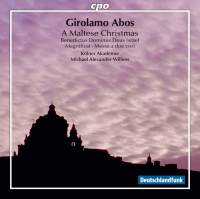Texte paru dans: / Appeared in: |
|
|
Outil de traduction ~ (Très approximatif) |
|
|
Reviewer: Joshua
Cohen This recording, taken from a public concert in January 2015, is a delightful discovery. Girolamo Abos (1715–1760) was a Maltese composer who spent most of his career in Naples, where he taught at the Conservatorio de Saint’Onofrio and produced a large body of sacred music as well as several operas. Stylistically his music falls into that intermediate period—call it post-Rococo or early Classical—between the heyday of Bach and Handel and the maturity of Haydn and Mozart. It is, in other words, an elegant, clean-limbed style that emphasizes simple melody and clear textures over harmonic complexity and dense polyphony. Counterpoint (a hallmark of the high Baroque style) is kept to a minimum, and the instrumental writing always supports the vocal line rather than competing with it. Abos’s music isn’t especially dramatic, profound, or sensuously alluring, but it’s unfailingly graceful, cultured, and immediately appealing. It is music that aims to please, but its pleasures are of an exceptionally refined order. The program consists of three choral works that were probably written during the decade of the composer’s life (though only the Mass for Double Chorus, published in 1756, has been definitively dated). At just under 30 minutes, the Mass—or more properly, Missa Brevis, since only the Kyrie and Gloria sections are included—is the most ambitious offering: a series of lively, compact choral movements interspersed with brief soprano solos, and concluding with a noble and rather inspiriting Cum Sancto Spiritu. Other highlights include Et misericordia from the Magnificat, with its gentle, poignant chromaticism and the jauntier Fecit potentium that follows. But again, this isn’t the sort of music you’d go to feast on, rather, shall we say, a light but elegantly prepared musical luncheon. For reasons that are not made clear, the Kölner Akademie assigns one singer to each choral part (in the manner of Joshua Rifkin’s performances of Bach’s sacred music), so that the total number of singers employed ranges from four (in the four-part Magnificat) to 10 (in the five-part double chorus Mass). The disadvantage of this practice is that in movements where brief solos or solo ensembles are inserted into choral movements, it can sometimes be difficult to tell where the solo writing ends and the choral writing resumes. The gain in freshness and transparency outweighs the drawbacks, however, and the five young soloists (who also make up the first choir in the Mass) are a gifted group. Fine playing, stylish conducting, and a well-balanced recording by German radio complete the virtues of a delightful and easily recommendable disc. | |
|
|
|
|
Cliquez l'un ou l'autre
bouton pour découvrir bien d'autres critiques de CD |
|




